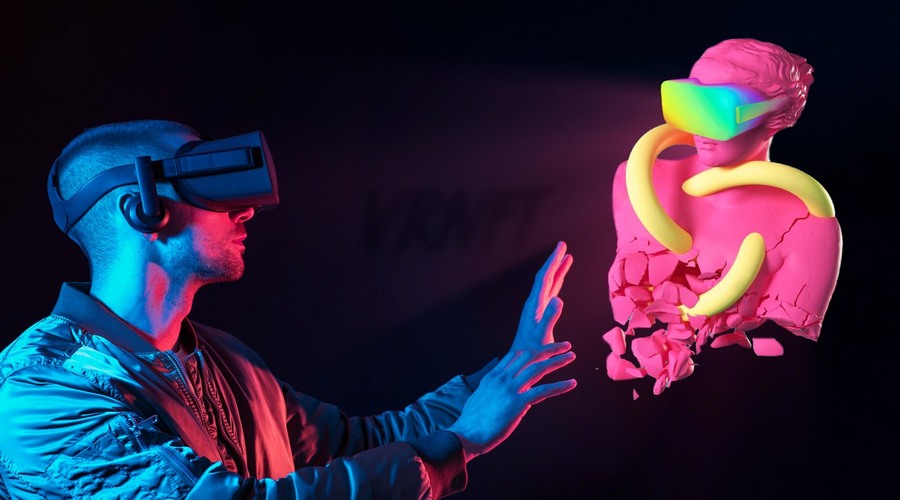As virtual reality (VR) technology continues to advance, the potential for new applications and use cases is rapidly expanding. One area where VR and blockchain technology intersect is through Non-Fungible Tokens (NFTs). In this article, we will explore the role of NFTs in the emerging field of VR, including their potential applications and benefits.
Introduction
In this section, we will provide an overview of NFTs and VR technology, and how they are related. We will also discuss the potential benefits of using NFTs in the context of VR.
What are NFTs?
NFTs, or Non-Fungible Tokens, are unique digital assets that use blockchain technology to verify ownership and authenticity. NFTs can represent anything from artwork to virtual real estate, providing a secure and transparent way to buy, sell, and trade digital assets.
What is Virtual Reality?
Virtual reality is a computer-generated environment that simulates a realistic experience. Users can interact with the virtual environment through a headset or other devices, creating a sense of immersion and presence in the virtual world.
NFTs in VR: Potential Benefits
NFTs can provide a secure and transparent way to buy, sell, and trade virtual assets in the context of VR. This can lead to new opportunities for creators, developers, and users alike. NFTs can also enable the creation of unique and scarce virtual assets, which can have value in the same way as physical assets.
Applications of NFTs in VR
In this section, we will explore some of the potential applications of NFTs in the context of VR. We will discuss how NFTs can be used to create unique virtual assets, enable new forms of digital ownership, and support virtual economies.
Unique Virtual Assets
NFTs can enable the creation of unique virtual assets in the context of VR. For example, a digital artist could create a one-of-a-kind virtual sculpture and sell it as an NFT. The buyer would then have exclusive ownership and control over the asset, creating a sense of rarity and uniqueness.
Digital Ownership
NFTs can provide a new form of digital ownership in the context of VR. With NFTs, users can prove ownership and authenticity of virtual assets, such as virtual real estate or in-game items. This can create new opportunities for trading and investing in virtual assets, similar to the way physical assets are bought and sold.
Virtual Economies
NFTs can support virtual economies in the context of VR. In virtual worlds, such as Decentraland or Somnium Space, users can buy and sell virtual real estate and other virtual assets using cryptocurrency and NFTs. This creates a new economy with its own rules and dynamics, enabling new forms of value creation and exchange.
Challenges and Limitations
While the potential applications of NFTs in VR are vast, there are also challenges and limitations to consider. In this section, we will discuss some of these issues.
Technical Limitations
The current state of VR technology presents technical limitations that can hinder the adoption of NFTs in VR. For example, the storage and processing requirements for VR environments can be high, which can limit the size and complexity of virtual assets.
Legal and Regulatory Issues
The use of NFTs in the context of VR raises legal and regulatory issues, such as intellectual property rights and tax implications. The ownership and transfer of virtual assets can be complex, and there may be legal gray areas that need to be addressed.
Accessibility and Inclusivity
The use of NFTs in VR may create accessibility and inclusivity issues, as not everyone has access to the technology or the resources to participate
Environmental Concerns
The production and use of VR technology and NFTs can have significant environmental impacts, such as energy consumption and carbon emissions. The sustainability of these technologies in the long term is an important issue that needs to be addressed.
Security and Privacy
The use of NFTs in the context of VR raises security and privacy concerns, such as the potential for theft or unauthorized access to virtual assets. As virtual assets become more valuable, the risk of theft and fraud increases, requiring robust security measures to be put in place.
Case Studies: NFTs and VR
In this section, we will examine some case studies of NFTs and VR in action.
Somnium Space
Somnium Space is a virtual reality platform that uses blockchain technology and NFTs to create a decentralized virtual world. Users can buy and sell virtual real estate and other virtual assets using cryptocurrency and NFTs, creating a new economy with its own rules and dynamics.
Decentraland
Decentraland is another virtual reality platform that uses blockchain technology and NFTs to create a decentralized virtual world. Users can buy and sell virtual real estate and other virtual assets, as well as create their own virtual experiences using Decentraland’s SDK.
CryptoKitties
CryptoKitties is a blockchain-based game that uses NFTs to create unique and collectible virtual cats. Players can breed and trade their virtual cats, creating a new form of digital ownership and value creation.
Conclusion
In conclusion, NFTs have the potential to revolutionize the emerging field of virtual reality by enabling the creation of unique virtual assets, enabling new forms of digital ownership, and supporting virtual economies. However, there are also challenges and limitations that need to be addressed, such as technical limitations, legal and regulatory issues, accessibility and inclusivity, environmental concerns, and security and privacy. As VR technology and NFTs continue to advance, it is important to consider these issues and work towards a more sustainable, inclusive, and secure future.






